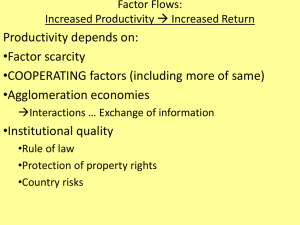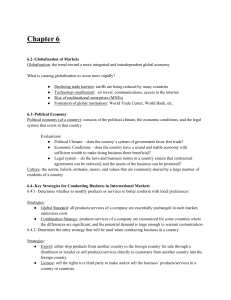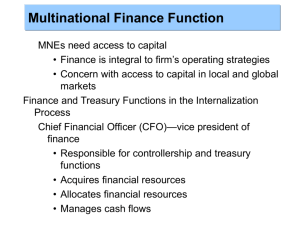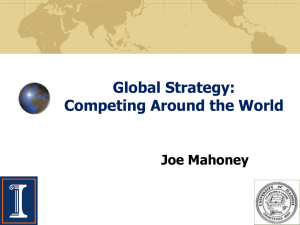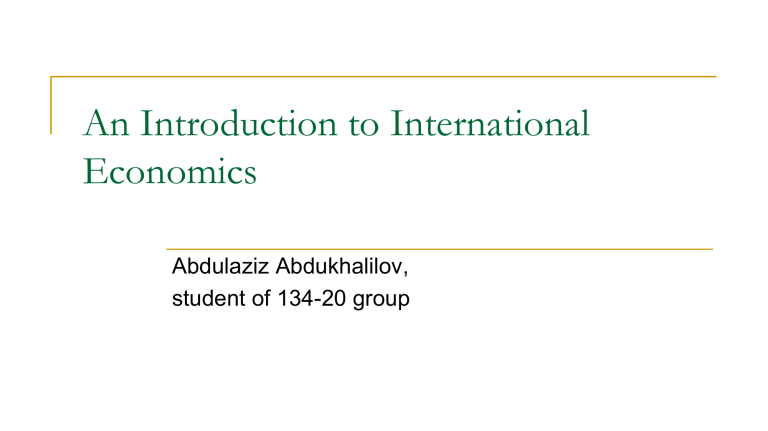
An Introduction to International Economics Abdulaziz Abdukhalilov, student of 134-20 group Introduction Task we take up in this subject — exploring key aspects of globalization We will try to explore the world economy and globalization in as balanced a manner as possible This will help us develop informed views and opinions Introduction International economy explores three realms of the modern world economy International trade International production International finance International Trade The exchange of both goods (merchandise) and services among the countries of the world. Goods: tangible and storable (something you can drop on your toe). Services: intangible and non-storable (something you cannot drop on your toe). Trade in services accounts for approximately one fifth of global trade. The two are often intertwined. Figure 1.1 Gross Domestic Product and Exports in the World Economy, 1970 to 2018 (1970=100). Source: World Bank, World Development Indicators Expansion of international trade There are many reasons for the expansion of world trade: Transportation: the container shipping revolution Technology: information and communication technology (ICT) Tariffs: trade liberalization Entry of China: market reforms beginning in the late 1970s; joining the World Trade Organization (WTO) in 2001 Figure 1.2 Exports as a percentage of GDP, China and Germany, 1990 to 2018. Source: World Bank, World Development Indicators China’s exports as a percentage of GDP are substantially lower than those of Germany and have been decreasing since 2006. International Trade We’ll explore the major factors underlying international trade. Key concepts include: Comparative advantage World Trade Organization Preferential trade agreements A full understanding of the factors underlying international trade will also require an understanding of international production. International Production Production of a product in multiple countries Can take place through Non-equity contracting Foreign outsourcing, licensing and franchising Foreign direct investment (FDI) undertaken by multinational enterprises (MNEs) Involves firms based in one country owning at least a 10 percent of firms producing in another country International Production MNEs are particularly important actors in the world economy. MNEs account for approximately one fourth of world gross domestic product (GDP) or aggregate output. The sales of foreign affiliates of MNEs now exceed the volume of world trade. MNEs are involved in approximately three fourths of all world trade. Approximately one third of world trade takes place within MNEs. MNEs account for approximately three fourths of worldwide civilian research and development. Figure 1.3 Nominal FDI Inflows to Low, Middle and High Income Countries, 1970 to 2018. Source: World Bank, World Development Indicators. International Production Both contracting relationships and FDI are configured between countries in global value chains (GVCs). GVCs: systems of value chains linked together in buyer-supplier or ownership relationships across countries ICT-enabled GVCs are the defining feature of modern globalization (Baldwin 2016) Migration: relevant to international production 3 to 4 percent of the world’s population has migrated International Finance Refers to the exchange of assets among countries Individuals and firms around the world conduct international transactions in Currencies Equities Government bonds Corporate bonds (commercial paper) Real estate Plays increasingly important role in the world economy: foreign exchange transactions are much larger than trade transactions Figure 1.4. Daily Foreign Exchange Market Turnover and Annualized Multiple of Exports, 1989-2016. Sources: Bank of International Settlements, Triennial Central Bank Surveys, and World Bank, World Development Indicators International Finance Capital flows of global finance: can be destabilizing (balance of payments crises, financial crises) A process known as capital flight: investors selling a country’s assets and reallocating their portfolios into other countries’ assets The Global Financial Crisis beginning in 2008, with roots in the US housing market. Its most severe effects were felt in Europe. International finance is a realm of increasing importance in the modern world economy. Impacts on International Development It is hoped that the processes of international trade, production and finance will contribute to international development, namely improved levels of welfare and standards of living throughout the world. Two major issues usually arise how we conceptualize levels of welfare or standards of living. how the processes of international trade, international production, and international finance support or undermine international development. Neither of these issues has been fully settled. Impacts on International Development Different ways of defining development: Mainstream economics: gross domestic product per capita (the average value of production produced by a citizen of a country) Main alternative: the “capabilities” approach, which assesses development outcomes in terms of a range of human capabilities—things people can actually achieve Limitation: GDP is not a measure of welfare The capabilities approach is often assessed using the Human Development Index (HDI), developed by the UNDP Per capita income Average life expectancy Average levels of education Development outcomes vary widely across countries Table 1.1. Measures of Living Standards (2017). Sources: databank.worldbank.org; hdi.undp.org Larger Realms Processes of international economics are strongly influenced by “CEPT”: Culture Environment Politics Technology Analytical Elements Countries Sectors Tasks Firms Factors of production Currencies Financial assets
